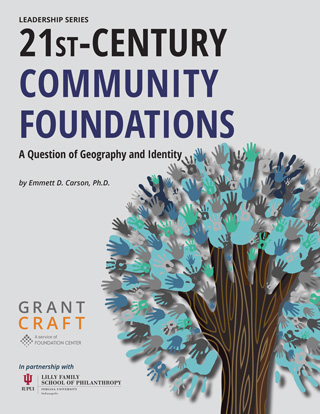21st-Century Community Foundations A Question of Geography and Identity
In this “Leadership Series” paper, Emmett Carson, CEO and president of Silicon Valley Community Foundation, provides a thoughtful examination of fundamental questions facing U.S. community foundations today. Acknowledging that a key characteristic of community foundations is their leadership and civic engagement within their stated geographies, Emmett explores how these institutions are engaging with donors who have a wide range of interests in diverse geographic areas. 21st-Century Community Foundations is intended to be a springboard for the ongoing conversation about the changing definition of “community.”
Discuss this resource and help spread the word by tweeting!
- Introduction: Community foundations are entering an era of unprecedented change and proliferation of needs, approaches, and methodologies. This guide will explore this precipitous moment in the history of community foundations, and seeks to look forward towards the next phase of this sector’s mission and impact.
- What is the Meaning Of Community?: As community foundations, what do we mean by the term “community”? Some of the difficulty in defining community comes from its dual meaning, attached to both people and place. Compounding this duality is the increasing ease of connecting through digital spaces. Unpacking our understanding of community is a crucial step towards furthering our impact as community foundations.
- Donor Advised Funds Are Not Created Equal: Conversations on donor advised funds often leave out the vast differences between donor advised fund providers. We dive into what distinguishes different types of donor advised funds, how different providers engage with them, and what role these funds will play in the future of community foundations.
- A Crisis of Identity: Individuals are more mobile and more saturated with ways to give than ever before. Community foundations face the greatest identity crisis they’ve faced in the last century. We take a look at what this means for our value propositions, and how community foundations are thinking strategically about their roles and impact.
- Community and Financial Viability: Periods of transition bring not only new challenges, but new opportunities for growth and innovation. Community foundations will need to think long-term to avoid potential pitfalls and find new areas of growth.
- Conclusion: Global society is becoming more dynamic and interconnected, and community foundations must adapt. Community foundations are experiencing a "coming of age," and while this may force us to step beyond our comfort zones, engaging effectively with this new paradigm can allow community foundations to play a major role in meeting the challenges of our day.

Categories
Content type
Strategies
Issues
In this “Leadership Series” paper, Emmett Carson, CEO and president of Silicon Valley Community Foundation, provides a thoughtful examination of fundamental questions facing U.S. community foundations today. Acknowledging that a key characteristic of community foundations is their leadership and civic engagement within their stated geographies, Emmett explores how these institutions are engaging with donors who have a wide range of interests in diverse geographic areas. 21st-Century Community Foundations is intended to be a springboard for the ongoing conversation about the changing definition of “community.”
Discuss this resource and help spread the word by tweeting!
- Introduction: Community foundations are entering an era of unprecedented change and proliferation of needs, approaches, and methodologies. This guide will explore this precipitous moment in the history of community foundations, and seeks to look forward towards the next phase of this sector’s mission and impact.
- What is the Meaning Of Community?: As community foundations, what do we mean by the term “community”? Some of the difficulty in defining community comes from its dual meaning, attached to both people and place. Compounding this duality is the increasing ease of connecting through digital spaces. Unpacking our understanding of community is a crucial step towards furthering our impact as community foundations.
- Donor Advised Funds Are Not Created Equal: Conversations on donor advised funds often leave out the vast differences between donor advised fund providers. We dive into what distinguishes different types of donor advised funds, how different providers engage with them, and what role these funds will play in the future of community foundations.
- A Crisis of Identity: Individuals are more mobile and more saturated with ways to give than ever before. Community foundations face the greatest identity crisis they’ve faced in the last century. We take a look at what this means for our value propositions, and how community foundations are thinking strategically about their roles and impact.
- Community and Financial Viability: Periods of transition bring not only new challenges, but new opportunities for growth and innovation. Community foundations will need to think long-term to avoid potential pitfalls and find new areas of growth.
- Conclusion: Global society is becoming more dynamic and interconnected, and community foundations must adapt. Community foundations are experiencing a "coming of age," and while this may force us to step beyond our comfort zones, engaging effectively with this new paradigm can allow community foundations to play a major role in meeting the challenges of our day.



